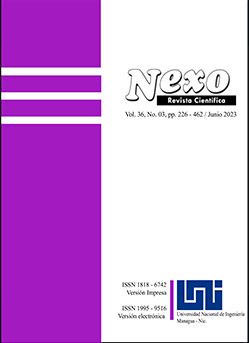Using the band ratio approach, FULL-PIXEL (SAM and SFF) and SUB-PIXEL (MF and SID) methodologies to discover areas with alteration using the Aster sensor: a case study in north westen Iran - Sivardaghi Area
DOI:
https://doi.org/10.5377/nexo.v36i03.16464Keywords:
Geochemical alteration detection, full-pixel and sub-pixel mapping, spectral angle mapper method, matching filter algorithm and pure endmemberAbstract
ASTER sensor data is among the most potent satellite data accessible for doing geological investigations, with images for the whole earth's surface. In order to test the capability of this sensor to detect places with geochemical alterations, photographs of Mount Seiver Daghi in the western Iranian province of Samal were utilized in this study. This region, which comprises of magmatic and volcanic terrain, is part of the Arsbaran territory and is covered by intrusive masses with alluvial and sedimentary deposits. To conduct this study, an ASTER measuring frame was utilized, which, after performing atmospheric corrections using the internal average relative reflectance (IARR) method of false color composite images and principal component analysis (PCA), was able to differentiate between different lithological units using the Band assignment method, full-pixel methods of spectral angle mapper (SAM) and base spectrum algorithm of spectral feature fitting (SFF) as well as sub-pixel methods of matched filtering. The study demonstrates that the approach of principal component analysis and false color composition is efficient for distinguishing sedimentary rock units from igneous rock units, and its application is suggested for the designated rock units. Due to the lack of spectral characteristics of feldspars and quartz in the short infrared wavelength range, the basic spectrum methods utilized in this work are incapable of identifying such minerals. It is not advised to use these algorithms to distinguish between various magmatic units.
Downloads
Downloads
Published
How to Cite
Issue
Section
License
Copyright (c) 2023 Array

This work is licensed under a Creative Commons Attribution 4.0 International License.
The authors who publish in Nexo Scientific Journal agree to the following terms:
- Authors retain the copyright and grant the journal the right of the first publication under the license Creative Commons Attribution License https://creativecommons.org/licenses/by/3.0/, which allows others to share the work with a recognition of the authorship of the work and the initial publication in Nexo Scientific Journal.
- Authors may separately establish additional agreements for the non-exclusive distribution of the version of the work published in the journal (for example, in an institutional repository or a book), with the recognition of the initial publication in Nexo Scientific Journal.
- Authors are allowed and encouraged to disseminate their works electronically (for example, in institutional repositories or in their own website) before and during the submission process, as it can lead to productive exchanges, as well as earlier and greater citation of published works.











